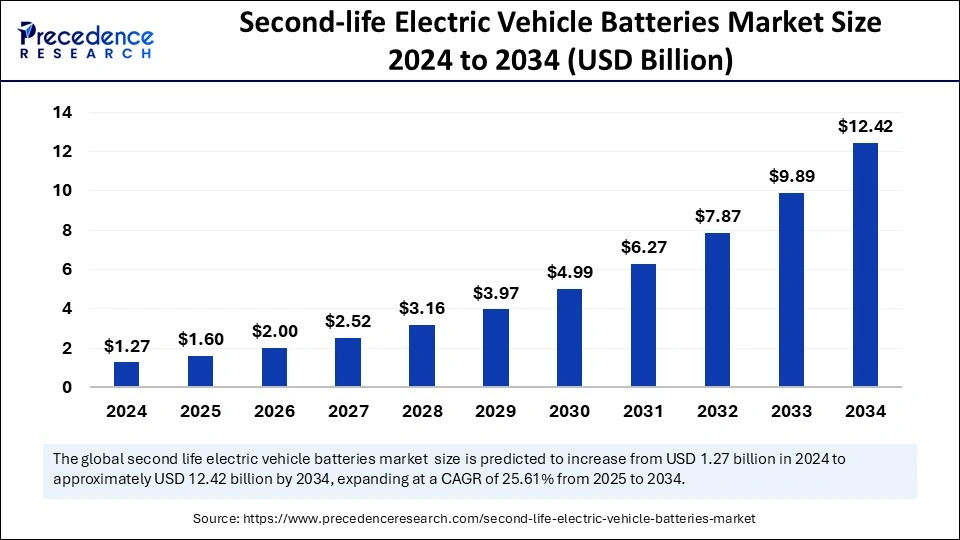Second-life EV Batteries Market Set for USD 12.42 Bn Growth by 2034
Second-life EV batteries market is expected to reach USD 12.42 billion by 2034, up from USD 1.27 billion in 2024,Growing at a CAGR of 25.61%
Second-life EV Batteries Market Key Takeaways
- Asia Pacific dominated the second-life electric vehicle batteries market with the largest share in 2024.
- Europe is projected to witness the fastest growth between 2025 to 2034.
- By battery type, the lithium-ion segment dominated the market in 2024.
- By battery type, the lead-acid segment is expected to grow at a significant rate during the forecast period.
- By application, the power backup segment held the largest share of the market in 2024.
- By application, the EV charging segment is projected to grow at a rapid pace during the forecast period.
- By end-use, the commercial segment dominated the market in 2024.
- By end-use, the residential segment is expected to experience the fastest growth between 2025 to 2034.
Second-life EV Batteries Market Overview
The second-life electric vehicle (EV) batteries market is emerging as a critical component of the circular economy, enabling the reuse of EV batteries in applications beyond their initial use. As electric vehicles continue to gain widespread adoption, a growing number of batteries are reaching the end of their automotive life cycle, creating a surplus of retired batteries with residual capacity. These second-life batteries can be repurposed for various applications, including renewable energy storage, grid balancing, backup power, and microgrid solutions.
The shift toward sustainable energy systems, coupled with increasing concerns about battery waste and environmental impact, has prompted stakeholders across the automotive, energy, and technology sectors to explore innovative solutions for repurposing retired EV batteries. Moreover, advancements in battery diagnostics, predictive analytics, and smart grid technologies are enhancing the viability of second-life battery applications, driving market growth. As governments worldwide promote circular economy models and sustainable practices, the second-life EV battery market is poised for significant expansion.
Second-life EV Batteries Market Drivers
Growing Focus on Circular Economy and Resource Optimization: The push toward minimizing waste and maximizing the value of EV batteries aligns with the principles of a circular economy, driving market growth.
Increasing Demand for Renewable Energy Storage Solutions: Second-life batteries provide a cost-effective means of storing energy generated from renewable sources, supporting the transition to clean energy.
Rising Number of Retired EV Batteries with Residual Capacity: The growing adoption of EVs is resulting in an increasing supply of batteries suitable for second-life applications.
Supportive Government Policies and Incentives: Regulatory frameworks promoting battery recycling and reuse are creating a conducive environment for the growth of the second-life battery market.
Second-life EV Batteries Market Opportunities
Expansion of Energy Storage Solutions in Developing Regions: Second-life batteries can be deployed in developing regions to provide affordable and reliable energy storage solutions.
Integration of Second-life Batteries into Smart Grids and Microgrids: The use of second-life batteries in smart grid applications can enhance grid stability and facilitate the integration of renewable energy sources.
Development of Innovative Business Models for Battery Repurposing: New business models focused on leasing, subscription, and battery-as-a-service (BaaS) can unlock additional value from second-life batteries.
Adoption of AI and IoT for Battery Monitoring and Management: The application of AI and IoT technologies in battery monitoring and management can improve the performance and longevity of second-life batteries.
Second-life EV Batteries Market Challenges
Uncertainty in Battery Performance and Long-Term Reliability: The variability in battery degradation and performance over time poses challenges for predicting the long-term reliability of second-life batteries.
Regulatory and Legal Complexities in Battery Reuse and Recycling: Compliance with evolving regulatory standards and managing liability risks associated with second-life batteries remain critical challenges.
High Costs Associated with Battery Collection, Testing, and Repurposing: The cost of collecting, testing, and repurposing retired EV batteries can limit the scalability of second-life applications.
Lack of Public Awareness and Acceptance of Second-life Battery Solutions: Educating stakeholders about the benefits and safety of second-life batteries is essential for driving market adoption.
Second-life EV Batteries Market Regional Insights
North America: Dominates the market due to the increasing adoption of EVs, supportive government policies, and growing investments in battery recycling infrastructure.
Europe: Witnesses strong growth driven by strict environmental regulations, circular economy initiatives, and rising demand for renewable energy storage solutions.
Asia Pacific: Poised for rapid growth due to the expansion of the EV market, government support for sustainable practices, and increasing demand for energy storage systems.
Second-life EV Batteries Market Recent Developments
Deployment of AI-based battery management systems to improve the efficiency of second-life battery applications.
Launch of pilot projects and demonstration programs to assess the performance and scalability of second-life battery solutions.
Expansion of partnerships between automakers, energy companies, and technology providers to develop sustainable battery ecosystems.
Introduction of new regulatory frameworks to ensure the safe and effective use of second-life EV batteries.
Second-life Electric Vehicle Batteries Market Companies
- Enel X
- Nissan Motors Corporation
- Fortum
- Renault Group
- Mercedes-Benz Group
- Hyundai Motor Company
- RWE
- Mitsubishi Motors Corporation
- BELECTRIC
- BeePlanet Factory SL
- B2U Storage Solutions, Inc.
- RePurpose Energy Inc.
- ReJoule
- Cactos Oy
- ECO STOR AS
- Connected Energy Ltd.
- Smartville Inc.
- Lohum Cleantech Private Limited
- DB Bahnbau Gruppe GmbH
Segments Covered in the Report
By Battery Type
- Lithium-ion
- Nickel-Metal Hydride
- Lead-Acid
By Application
- Power Backup
- Renewable Energy Storage
- Grid Connected
EV Charging
By End Use
- Commercial
- Residential
- Industrial
By Geography
- North America
- Europe
- Asia-Pacific
- Latin America
- Middle East and Africa
Ready for more? Dive into the full experience on our website!

